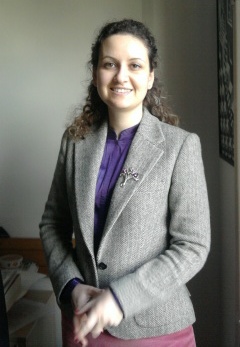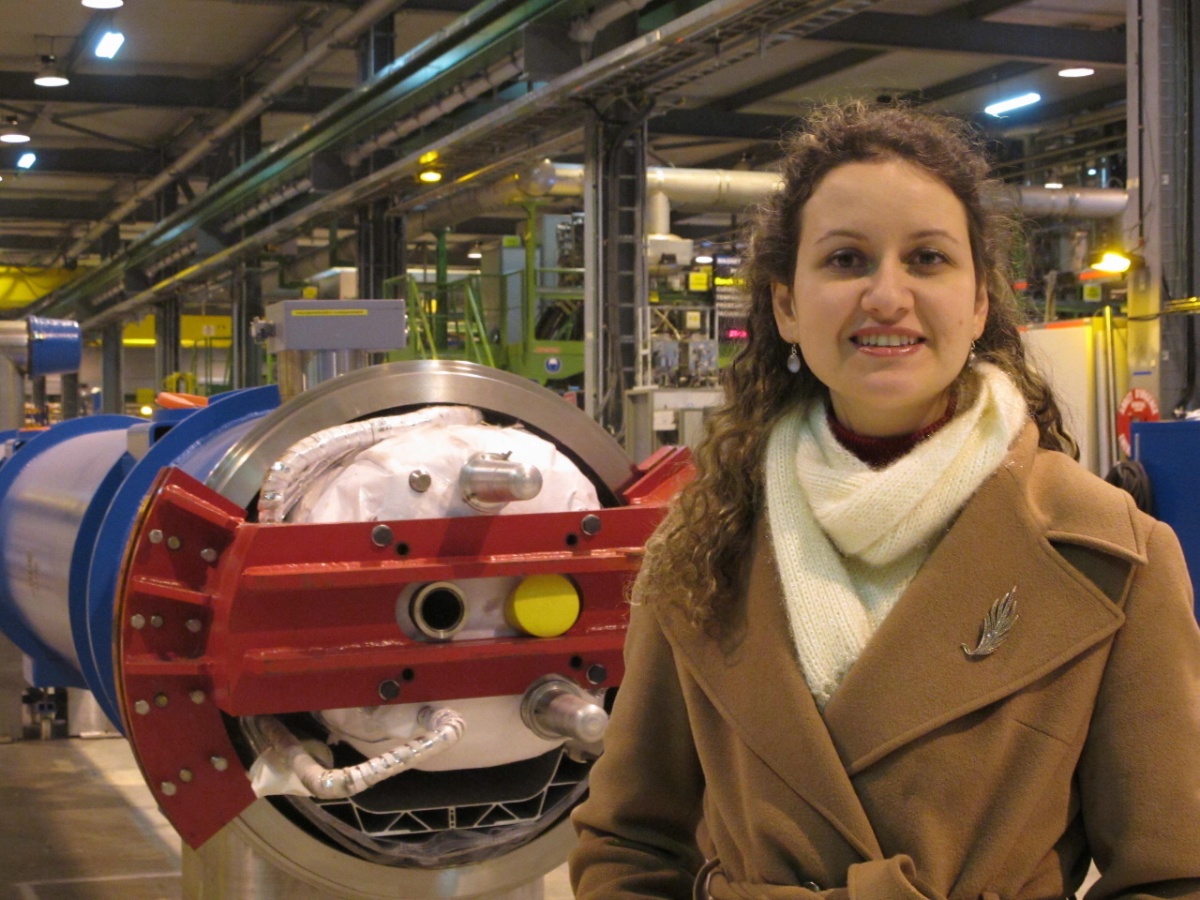
“…the driving force is the curiosity of a six-year-old child which is still with me even now and I hope that it persists with me for the rest of my life because it is the energy that I find in me to carry on.”
“I am happy to say that I have co-authored some of the first papers that came out of the ATLAS Experiment; we have about twenty so far. It is very nice and exciting to see this data. It is a wonderful time for us because we have not found anything new yet, but we know that we are at the edge of it. We know whatever we’ve seen is, in essence, finding something new because we are doing something that nobody has done before.”
“… only 4 percent of the energy budget of the universe is made from matter like us. That includes the earth, the sun, including all the stars that you see; including the Milky Way and Andromeda, which is the closest galaxy, including all the galaxies that we can see, all the pretty pictures that Hubble has taken, everything… All of these constitute only 4 percent of the budget, so what is the rest then? That’s a bit more complicated. We know now that 23 percent is dark matter, and the rest is an even more mysterious dark energy; 73 percent. This 73 percent is a crazy thing because it tells us that there is an unknown energy in the universe, which makes it expand and we have no clue what this energy is.”
“The Higgs is special because it is a field we think fills the universe, it fills the space .… the Higgs will explain why the 4 percent has mass ….The Higgs field is certainly not God, it just something that gives you mass, that’s all! ….. Therefore the analogy of “God particle” does not work at all for me!”
Q: Thank you very much for accepting to do this interview with us. Could we start with your academic career, how you have chosen this field?
BD: The main drive behind my academic career is my curiosity to find out what the universe is made out of and how it started. So the driving force is the curiosity of a six-year-old child which is still with me even now and I hope that it persists with me for the rest of my life because it is the energy that I find in me to carry on. At high school, I was not a good test-taker even if all my teachers thought that I was a good student, they were quite worried about that I will not do well in the university entrance exams. I could never finish a test on time because I have always been and still I am, a slow-thinker and it has helped me many times. In some sense in our society, there is big misconception of thinking that someone who thinks fast is a smart one. I do not think so; what is important is to get to the right answer at the end. Besides, tests were not on my radar screen: I wanted to pursue my questions about the universe. My teachers, particularly one; my math teacher Selim Tezel thought that I needed to start research sooner then later: do research as an undergraduate rather than waiting for master, PhD. etc. That is why I thought I should try to go abroad, to MIT, because they have this UROP (Undergraduate Research Opportunities Program) where even as a freshman, you can start doing research. I hope that one day we will be able to implement it here at METU. I think it is very important for undergraduates to start thinking about research, use their creative skills in the area of their interest, early on. In my view, the university entrance exam often kills the six-year-old child in us, whereas we should never give it up as it is the driving force both in doing research and in our life. That curiosity, that untainted love for nature, should continue to be our driving force. But often life, exams and stress can silence that child, while research can revitalize it. I now have four undergraduates working with me and I think that it will be a wonderful thing if we can continue this initial momentum. When I went to MIT, this was not possible to do much research as an undergraduate in the Turkish universities and now I think there is a bit more openness in getting people into the research as soon as possible and it seems that people recognize its importance.
At MIT, I was very happy because I could immediately get into research. Even as a freshman, it was wonderful to do mathematics research. I have stayed all the summers of my university years in MIT, doing research; except one where I went to Mainz, Germany but even there I worked on particle physics. As a student there you can earn a little bit of money by doing research and this is part of the financial support program.
To make a long story short, I studied physics because in my view physics is the purest science. I also studied mathematics because mathematics is the language of physics and the better mathematics you know the better chance you have in understanding nature at large. And I studied music because I think that music is the other language that nature speaks to us. I sometimes think that Beethoven understood the universe much better than I do!
Q: After terminating the undergraduate program, how did you decide in which university you will continue your research?
BD:After finishing university at MIT, I started my PhD in MIT. Actually I applied to four universities, MIT, Caltech, Stanford, and Harvard. I was expecting to get into one and I got accepted to all four! It was amazing at first but then I realized how difficult it was to make a decision. At that point I took the wrong turn maybe, and decided to stay at MIT while everybody else told me to leave, as to avoid inbreeding.
Q: So why did you prefer to stay at MIT for PhD?
BD: I stayed for a reason: I wanted to stay at MIT in order to continue working on trying to find a dark matter signal. As an undergraduate, I had already started to work on a project called AMS (Alpha Magnetic Spectrometer) which is a particle physics experiment in space. It was launched to space on 16th of May, 2011. I am very proud that it is finally in space. I started working on it as an undergraduate and continued for my PhD – a total of 4,5 years. It was launched on the space shuttle and was installed on the ISS (International Space Station). It will stay there for probably 10 years and it will look up for dark matter and anti-matter in space.

There is also a METU team working on the data analysis of the AMS-02 (Alpha Magnetic Spectrometer) experiment which was installed on the International Space Station, on the 16th of May, 2011.
I have always wanted to find dark matter from the first time I have heard about it. So I thought that I should stay on this experiment at MIT and continue working on dark matter. But in 2002 if you remember, the space shuttle Columbia had an accident as it was entering Earth’s atmosphere and it and its crew were lost when it disintegrated. All of a sudden, I found myself in an open-ended PhD program! MIT requires you that you finish your project and publish results before you graduate. When you are disappointed in such a way, you feel yourself very lost surely and as you can imagine, I was very lost and depressed.
Q: What did you did you do then?
BD: After some time of not knowing what to do, I have decided to leave it and go back to Europe. I wrote up what I did for AMS in the four years, for the master’s thesis. And then I went to Oxford to get my D.Phil. – there, it is not called a Ph.D!
Q: How many years did you spend at total at MIT for undergraduate and graduate?
BD: I was an undergraduate for four years and PhD student for three years, so seven years at total at MIT. And then I went to Oxford and I was a PhD student for 3 years but most of that time I actually spent at CERN. The best thing about being in Oxford was that we were assembling there one of the world’s largest silicon detectors. It was amazing because it was the central piece of the ATLAS detector at CERN, the silicon detector is 61 m2 of silicon. That is an amazing piece of technology which sees particles as they flow out of this collision point. So I started to work on the ATLAS Experiment and I decided that I am a “dark matter person” and that I should look for dark matter with the ATLAS Experiment. I think, when you have a goal, you don’t change it: there are different ways of going for the same thing. I was very happy about being at the right time at the right place because it was a beautiful team effort to build this amazingly beautiful detector.
Q: What is this for?
BD: At the Large Hadron Collider (LHC), we collide particles which are going very close to speed of light. When we collide them, they are only going a bike speed away from the speed of light. In the 27 km LHC ring, particles go around 11 200 times per second! And then, you have to collide them and that is a very tricky business. CERN has an amazing amount of technology built up on how to control these particles, how to accelerate them and how to collide them. This innovative technology is called “accelerator technologies” and then once the collision happens, then you have to detect the particles that are coming out of the collision point. This is called “detector technology.” So I have been involved in the detector technology. And I wrote my PhD thesis on detector technology which is quite close to electrical engineering. It was actually funny because I already had to learn a lot of mechanical engineering on AMS because of NASA requires so many tests for equipment that is going to go up on the shuttle. This is the joy of being an experimental physicist, if you want to run after the secrets of nature you have to use what the best engineering offers you, and sometimes, develop it even further.
We are doing nothing unnatural at the LHC, if you think about it. We are colliding particles close to the speed of light; people might think that it is very strange I say that since after all, we are trying to get a few protons to conditions similar to what existed at the beginning of the big bang; we are trying to simulate it in some way. But these collisions are happening all the time, at the top of our atmosphere; we are being bombarded by particles from space. We have the sun first of all, which sometimes flares; then we have supernova explosions, we have neutron stars, giant stars, shock and other accelerating mechanisms in the universe which spew out lots of high-energy particles that come and hit our upper atmosphere eventually. Those collisions that occur in the upper atmosphere are much higher energy than the ones which we can make at the LHC; it is not even comparable. And since the energies are much higher up there, if they asked me which collision you prefer, I would absolutely prefer the upper ones! We call them “cosmic rays” and we make good use of these collisions too: we use their remnants which are passing through us right now at a rate about one per second, to test our particle detectors. Nature gives them to us for free!
To make a long story short, for my PhD thesis, we tested the detector with cosmic rays because the LHC was delayed. Then I was chosen unexpectedly as a CERN fellow and I joined the ATLAS trigger team. The reason was that I had worked on the electronics and the software for the data that was coming out of detector, but what the LHC gives us is not just one collision; but about 40 million collisions per second. The trigger is the system which chooses which collisions to record from the 40 million.

Q: How?
BD: Inside this ring there isn’t just one particle running around, but there are billions of particles that are running around at certain intervals which we call bunches of particles. There is at this moment 1000 bunches each with 12 billion particles running around counter clockwise per bunch and 1000 bunches each with 12 billion particles running clockwise. This is done so that we can inject the particles into the ring, accelerate them and let them collide. When the bunches cross, only a few collide and get off the train and others continue turning. This is how we can have upto 30 million collisions per second and we have 25 nanoseconds between collisions. (There is a gap in the bunch structure.) Now, ATLAS Detector has 100 million channels of information which is like a camera of 100 megapixels (cameras are in general 7-8 megapixels these days). Let’s imagine a camera of 100 megapixels, in essence it would be the information output of the ATLAS Detector. The problem is you have a 100 megapixels camera but you are taking 40 million pictures for a second, so that’s petabytes per second! There is no one who can store petabytes of information per second. So what do you do? You select the frames or collisions that you like. It is like a soccer game: 7 or 8 TV channels are recording the game and there is a person who selects which camera gets to be aired. We have such a system, the selection is not done by human beings of course, nobody is that fast; it is done by an automatic system which looks at the signatures we want.
Q: Why that many collisions do you have?
BD: Why 40 million collisions per second? Because we want to find rare things as such dark matter, the Higgs particle, such as extra dimensions. The events which give us hints about new physics are extremely rare. So if you take 40 million collisions per second, may be a Higgs will come out every 10 minutes, that’s why you have to generate so many collisions. But then, you have to make sure when the Higgs comes out, you won’t miss it. From the physics theory, we have an understanding of what kind of events we want to record. There are only a handful stable particles in nature and these particles whether it be the Higgs or something else, eventually decay into these stable particles, called signatures. We can look for these, often high-momentum and central signatures, online and we can trigger on them. In this way, we can select the events we want to take and write to disc. Out of the 40 million collisions per second, we actually write to disc only 200 of them. This is called the triggering system and it is done in three levels, it is a dedicated and complicated system. I worked on this system for three years. Because as you can imagine before you do physics analysis, you have to understand this system well. It is crucial because you could throw away the signal, and if you do so, you are dead!
Since two years, or since the LHC started collisions and we started taking data, I have been working on the data analysis which has been extremely fun. I am happy to say that I have co-authored some of the first papers that came out of the ATLAS Experiment; we have about twenty so far. It is very nice and exciting to see this data. It is a wonderful time for us because we have not found anything new yet, but we know that we are at the edge of it. We know whatever we’ve seen is, in essence, finding something new because we are doing something that nobody has done before.
Q: As far as I understand, there are some results that you are expecting out of this experiment but there are also unexpected things that you may find out… And it seems that this unexpected part comprises a great piece of work. Am I right?
BD: Yes, absolutely. I think that the best thing that we can find is the unexpected. There are many theories, like the Higgs theory. For example if the Higgs theory is correct, we are expected to find the Higgs particle. It will give us a reason for the mass of everything around us except for the neutrinos; the only particles that the Higgs theory can not explain. We know that we have weight because our mass interact with gravity. But here, I am not talking about weight, I am talking about mass. Mass is something we know exists, but we don’t have a reason unless we choose to believe in the Higgs theory. I don’t choose not to believe in anything in science until I see the evidence for it because I think that’s the most important thing.
Another theory is SUSY, this is an acronym; the longer name is “Super Symmetry” and it predicts that every particle that we know has a partner which has a higher mass; a superpartner of every particle. For example electron has a superpartner called ‘selectron’. Well, I know it is bad naming, but physicists are not social scientists! So don’t expect good names from a physicist…
Super Symmetry is a theory that can explain dark matter as well as help solve a rather important mathematical problem in the theory of particle physics. Some theorists “believe in SUSY” but I choose not to believe in super symmetry either because we can test these theories and by doing so, understand more about nature. We sometimes say "believe" when we talk about science. But "believe" is not a scientific verb, that verb is "agree" or even better, "accept the evidence".
So first, we have to understand what comes out of the collisions. Most of the papers that we are publishing now are still about understanding the nature of collisions. For example the one that I co-wrote was on ‘jet shapes’, meaning it is on the shape of jets which result from ‘quantum chromo dynamics’. Jets do come out from the collision point and we look at the shape of these jets to understand them very well, before we can use them to search for a SUSY signature, for example. That is the state we are at; we are on one hand, trying to understand what is coming out and at the same time, we are trying to use what we know already in order to make measurements and test theories. The more you know what is coming out, the better you understand those objects, and the better your limits on new physics will be. There is a lot of room for improvement still, so I think some of these new physics searches will take some time.
Q: Why do you think people are so excited about the Higgs particle?
BD: I think it is partially because of Leon Lederman. He is a Nobel prize winning physicist and he wrote a popular science book called “The God Particle”. He was going to call it something else, and his editor proposed him to name the book “the God Particle” because he wanted to sell more books. But it has nothing to do with God. Yes, it is extremely important because it is the thing that generates mass of the particles we know of (except for neutrinos) supposedly, but the thing is, we look at the universe and what we have learned about the universe, we see that these particles only make up about 4% of the energy budget of the universe. How do we know that? Well, we can “hear” through our telescopes, the echo of the Big Bang. The Big Bang has left behind a signature in radio waves that we can still detect. We call it the “Cosmic Microwave Background Radiation” (CMB). This radiation was first detected in 1964 and since then, it has been measured to extreme accuracy, which led to two separate Nobel prizes once in 1978 and one in 2006. Because it has been measured to extreme accuracy, we have learnt about the universe, such as its age, which is 13.8 billion years. Another thing we have learnt is that only 4 percent of the energy budget of the universe is made from matter like us. That includes the earth, the sun, including all the stars that you see; including the Milky Way and Andromeda, which is the closest galaxy, including all the galaxies that we can see, all the pretty pictures that Hubble has taken, everything… All of these constitute only 4 percent of the budget, so what is the rest then? That’s a bit more complicated. We know now that 23 percent is dark matter, and the rest is an even more mysterious dark energy; 73 percent. This 73 percent is a crazy thing because it tells us that there is an unknown energy in the universe, which makes it expand and we have no clue what this energy is.
Q: And the Higgs particle is not expected to explain this part, is it?
BD: No, the Higgs will explain why the 4 percent has mass. Except the neutrinos and you can tell, that this bothers me.
Q: Will it explain “how” the mass has generated or “why” the mass exists?
BD: It will explain how it is generated. As for why there is a Higgs field, well, that’s a bit harder but in some extensions of the theory, or with SUSY, we might find deeper answers as well. It might be able to explain why dark matter has mass as well, if we find both the Higgs and SUSY particles, and other experiments confirm that dark matter is the lightest SUSY particle. But SUSY is not the only theory we have about dark matter luckily. It will be very very interesting if we can find a dark matter candidate at the LHC. The nasty part is that we do not have a theory of dark energy that we can test at the LHC.
Q: When will the LHC have an end?
BD: Never! No, I am joking! The LHC is now running at 7 TeV (Terra electron volts), which is half of the optimal energy. We plan to run this year and the next at 7 TeV (where 1 electron volt is the amount of energy that one electron needs to go up 1 volt potential). Before we can run at the LHC design energy of 14 TeV, we need to make sure of the LHC machine’s safety and therefore, we need a whole year of LHC and magnet repairs and upgrade. However, instead of doing those repairs right now, the CERN management decided to continue running at 7TeV because we are now in a race with Fermilab in the United States to find Higgs particle. While they are running at a lower energy (2TeV), their accelerator has been running for very many years and just reached the sensitivity to the Higgs particle -- they are on the verge to see the Higgs. We can do what they did in shorter time since the LHC is running at higher energies. So now, we are very much in a race with Fermilab. We should be able to say within two years whether or not the Higgs exists and once, we have the peace of mind, we hope to fix the remaining problems with the LHC and run at 14 TeV, where we will have a better chance to find dark matter candidates and extra-dimensions.
Q: So let me ask from the lenses of a social scientist, what should people expect from the finding of dark matter or the Higgs particle? In case of your finding, what will alter in the lives of people?
BD: We will say: “Oh that’s great we know what mass is about!” It will be a success of humanity but that’s all. Higgs will not change much about how I think about the universe except that I will know how mass has been generated. It’s a piece of the universal puzzle, but to me, every piece of knowledge we collect about the universe is special. When the US Senate questioned Robert Wilson, who would later become the director of Fermilab, in 1967 if it had anything to do with national security, he said: “It has only to do with the respect with which we regard one another, the dignity of men, our love of culture. It has to do with: Are we good painters, good sculptors, great poets? I mean all the things we really venerate in our country and are patriotic about. It has nothing to do directly with defending our country except to make it worth defending.” That resonates very deeply with me. Science (and arts) is what makes us human; it’s our ability to act on our scientific curiosity that makes us a civilization.
Mass is also something that I know it exists but in that case I will know how and that’s all. The Higgs is special because it is a field we think fills the universe, it fills the space. But this is now a new concept in particle physics; in particle physics, we already have a vacuum which is not empty. Quantum mechanics tells you that empty space is not actually empty.
Q: It is full of what, then?
BD: It is full of probabilities of particles jumping in and out of the vacuum. If it is empty, it’s empty but there is probability that for a very short time there could be a tiny little energy in there as long as it does not disobey the Heisenberg principle. Yes there is a chance that you could go to the moon and come back in a split second. You can calculate it’s probability; it’s very low but it is non-zero. According to quantum mechanics the empty space is full of these probabilities. On the top of the probabilities you can now add the Higgs. Now people say that if the Higgs field fills the universe than there is no God… The Higgs field is certainly not God, it just something that gives you mass, that’s all! Clearly if there is God, God is much more than something that gives you just mass. Therefore the analogy of “God particle” does not work at all for me!
Q: As far I can see this analogy is the main reason why people are excited about the outcome of this experiment because they think that it will provide an explanation to how universe is created...
BD: Yes, it will explain how universe is created up to some level, but not why, and maybe we will able to find dark matter and we will be able to explain to you for example why there is not much anti-matter in space. Because we did not find anti-matter in space yet but most of our theories would suggest that there should be some.
Q: Why?
BD: Because we think according to the laws of physics, matter and anti-matter should have been created on equal parts. But so far, we did not find any anti-matter nuclei in space but maybe we will find it with AMS, or maybe at the LHC, we will find why there is no anti-matter, and maybe nature favors matter over anti-matter. We seem to have some hints about it already, but we hope to understand it better. There is so much to do! If we can find a dark matter candidate or the Higgs, for example, it will be a huge step forward. When we find a particle at LHC for example, first we will publish it as “excess” or “particle” but people jump of course and say “it is Higgs, isn’t it?” But we haven’t proven that it is the Higgs. There are many things that we have to do in order to prove that it is Higgs; we have to measure the spin, its charge, we have to measure what it couples to (couples meaning how it interacts with other particles). You do not wake up one day and say “oh there is the Higgs!” As particles have many properties, you have to make sure that all the properties are actually what you think they are. So this is not a one-step game. I know that many people expect miracles, but I tell them miracles only happen by surprise. They happen occasionally, but they happen by surprise.
Q: So you think that expecting such an outcome from a scientific experiment is like expecting a miracle… It seems that people want to believe that this experiment will tell us about the existence of God…
BD: Yes, that’s what people want to believe. People have a romantic idea about science. Science is romantic but not in the way that the public understands. It is a romantic affair with nature but how it happens is not romantic.
Q: Maybe in the minds of people there are those films and novels where a scientist starts to believe in God after what s/he comes up with in a scientific research…
BD: Some people expect us to prove and some people expect us to disprove God, neither will happen. I think we will never be able to do so. It is not about whether God exists or not, it is understanding what creation is about. You may think that creation is made by God or spontaneously, this is your own decision. Many people think that the scientists at CERN do not believe in God, this is a wrong judgment because many people at CERN believe in God. There is no problem, nobody is trying to disprove God. There is no general CERN religious view.
Q: So you are saying that contrary to the general recognition, science and belief do not have to be at odds…
BD: Yes, they are not necessarily at odds but people generally want to see that they are; especially media provokes this thinking because it sells more.
Q: It seems that we will have to wait and see what will come out of this huge experiment! Let me ask you why did you choose METU at this stage of your career?
BD: Since the LHC has started taking data and it is now taking data stably, there is no drive for me to be continuously at CERN. It is very important to be there when the experiment starts up because you have to catch up with daily developments; things change very fast. But now we have come to a more stable state. So it was easier for me to finally return back home and I have been looking for this opportunity for many years. It has given me a chance to go back to my home country, to Turkey, to teach students here, to start something new… And also the CERN accession processes have started and I want to aid this process in any way I can. I also observe that there is now more funding in Turkey for the sciences, which is great. Especially experimental research is finding more support. I love my theoretical colleagues in this department, they are all very wonderful and there are working on important theories some of which we can test. I think the time is right for us to do more experimental particle physics in Turkey and I was encouraged to return to METU by Prof. Mehmet Zeyrek who has been very active at CERN for many years. I was also encouraged by the Head of the Physics Department, Prof. Sinan Bilikmen.
Q: Could we talk about your plans here? What are you intending to do in Turkey, specifically in METU? For example are you planning to initiate a laboratory working on these matters?
BD: It is perfect timing that AMS went to space just as I got my faculty position. I now have a discussion team on dark matter, preparing to AMS. It’s a very excited group of interested students. Actually, one of my students is now at CERN, working on AMS. Also, I want to do detector research and development with my students and lead the way in this field. Particle detectors are not just important for CERN, they are important for many applications such as nuclear safety, space research and science, biomedical imaging and treatments. For example, various developing techniques in cancer detection and treatment will make this field more and more interesting. I hope to build a particle detector R&D lab here and at the same time, continue working on data analysis of data coming from CERN.
Q: Lastly, you have also talked about the enhancement of the funding opportunities in Turkey, have you applied to any funding for your research here?
BD: Actually they look better than before, and yes I have applied to some of them. Unlike theorists who can work mostly with a piece of paper and pen, we; experimentalists cannot. In experimental physics, you can not do much without traveling because your collaborators are from all over the world. These big experiments that you want to participate in, require you to collaborate, as no country can build one by themselves, and therefore you have to travel to the experimental site or to your collaborator’s institute. In addition to travel costs, you need money to build the experiment itself: electronics, detector material, and computing all costs money. But the great thing about it, is that we might have an industrial return and often do. I gave an ATLAS tour to the Intel CTO many years ago and asked him why they gave so many processors to CERN for free. He said: “CERN experiences a technical problem about five years before the industry hits the same problem. So for us, it’s our test bed and early warning system: much like the canary in the coal mine”. That’s the nice thing about experimental physics: there is technological and industrial return, but it is a long-term investment. For example, the “www” came out of CERN. Is there a price tag on that? Not just that but in general, you see that overtime, the science at CERN had a wonderful return for the technological industrial programs in Europe in general.
Q: Thank you very much for kindly sharing your views and experiences with us.
BD: You are very welcome. It’s my pleasure.








